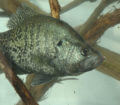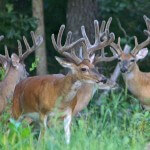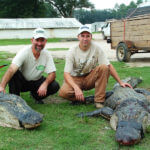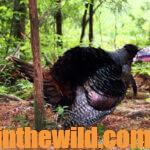John’s Note: Darrell Baker of Centre, Alabama, has been fishing and guiding on Weiss Lake in northeast Alabama for 40 years. He’s seen wintertime drawdowns and droughts and fished in freezing weather during the winter months. The State of Alabama has had one of the worst droughts that we’ve ever seen this past year in 2016. When we went fishing in the middle of November with the lake 6-feet below normal pool, I was surprised when Baker said, “The first thing we’re going to do is shoot docks.”
Spider Rigging:
When I hear the word spider rigging, the vision that comes in my mind is an angler or two on the front end of a boat with 8 or 10 poles and possibly an angler on the back of the boat with 3 to 5 poles trolling. However, the day I fished with Baker, we had two poles each on the front end of Baker’s boat, and the boat was moving at .1 or .2 mph as we fished the underwater river ledge. “In Alabama, Weiss Lake and the lake below it, Neely Henry, both have a 3-pole-per-angler limit on the number of poles we can fish,” Baker reports. “Fishing two rods per person makes the rods easier to watch, and our lines are far less likely to tangle. “We’re moving so slow that our baits are right under our poles. By having the poles 10-feet away from the boat, we’re catching crappie that I haven’t spotted yet on my Humminbird depth finder (http://www.humminbird.com/). We’re trolling about the same speed that people troll when their boats are only being pushed by the wind.”
 Baker prefers to troll into the wind instead of trolling with the wind. “By trolling into the wind, I can troll much slower than I troll with the wind. During the winter months, the slower you troll, the greater your odds for catching crappie. When you troll into the wind, you have much more control over the speed of the boat than you do when you’re trolling with the wind.”
Baker prefers to troll into the wind instead of trolling with the wind. “By trolling into the wind, I can troll much slower than I troll with the wind. During the winter months, the slower you troll, the greater your odds for catching crappie. When you troll into the wind, you have much more control over the speed of the boat than you do when you’re trolling with the wind.”
Small Hooks for Catching Crappie:
According to Baker, “I use two types of Tru-Turn (https://www.ttiblakemore.com) snelled hooks when I’m crappie fishing – #2 and #4. I like to use the #2 Tru-Turn snelled hook, because it’s a more-open hook with a wider gap than the #4. I use this hook when I’m fishing underwater structure that’s not quite as thick as the structure that I fish with a #4 Tru-Turn snelled hook. When I know I’ll be fishing really-thick brush, I prefer to fish the #4 Tru-Turn snelled hook, since it has a smaller gap between the point and the shank and lets the hook come through the limbs easier with fewer hang-ups than when I’m fishing a #2 hook. The smaller hook generally will catch as many crappie as the wider gap hook will.”
Baker’s main line is either 10- or 12-pound test line. When the hook touches brush, because the B‘n’M poles (https://www.bnmpoles.com/) are so sensitive, you can see the tip of the pole begin to move slowly toward the top of the water. “Many times if you’ll pick your rod up and open the bale on the reel slightly to feed out slack line and then shake your rod tip, the hook will come off the brush, and most of the time you won’t lose your bait,” Baker reports. “Often the hook won’t be what’s causing the hang-up. It may be the weight on the bottom of the line that’s causing you to get hung. So by just letting out slack and shaking your rod tip, you usually can get your line, hook and weight unhung.”
 Another problem that you often can have when you’re fishing river ledges is that the crappie are not the only fish in the lake holding on those ledges and brush piles. As Baker mentions, “We catch crappie, bass, saltwater stripers, catfish and every now and then bluegills when we’re fishing these river ledges. So, we have to have a line that is strong enough to help our anglers land fish this size.”
Another problem that you often can have when you’re fishing river ledges is that the crappie are not the only fish in the lake holding on those ledges and brush piles. As Baker mentions, “We catch crappie, bass, saltwater stripers, catfish and every now and then bluegills when we’re fishing these river ledges. So, we have to have a line that is strong enough to help our anglers land fish this size.”
Other Information from Baker to Improve Your Crappie Fishing:
* Set the Hook Hard. “When we’re fishing river ledges in the fall and winter, I tell my anglers to set the hook hard,” Baker emphasizes. “If you set the hook hard, many crappie fishermen believe that you’ll tear that small membrane on the edge of the crappie’s lip and lose the fish. I tell my anglers to set their hooks hard when they see their rod tips or lines twitch because when we’re fishing in heavy brush, as soon as that crappie takes the minnow, I want to turn its head up to get it out of the brush. Also when you set the hook hard and fast, a crappie won’t swallow the bait as deep in its mouth, which makes removing the hook easier and prevents killing young crappie that haven’t had time to swallow the bait and let the hook get into their gills or their stomach.
“Another advantage that we have with the B‘n’M poles is because these poles are so sensitive, when you set the hook hard, much of the force delivered to the point of the hook is absorbed by the bend of the rod. When you have a light rod that is very sensitive and flexible back to the midpoint of the rod, a good portion of the hook-setting energy goes into bending the rod instead of jerking the crappie’s lips off.”
 * Learn What Makes One River Ledge Better Than Another. “I don’t know that one river ledge is better than another river ledge, but I do know that the ledges with the most structure on them produce more crappie and often bigger crappie than the ledges with less structure on them,” Baker explains. “You may catch a crappie that is just relating to the water depth change on a river ledge. However, I’ve found that most crappie on river ledges will be holding close to the structure that’s on the ledges. I’m not fishing just the drop-offs. I’m fishing the brush piles, stump rows and/or natural wood that have been washed into and holding against the river ledge. The colder the water gets, the more concentrated – schooled up – the crappie will be holding on that structure.
* Learn What Makes One River Ledge Better Than Another. “I don’t know that one river ledge is better than another river ledge, but I do know that the ledges with the most structure on them produce more crappie and often bigger crappie than the ledges with less structure on them,” Baker explains. “You may catch a crappie that is just relating to the water depth change on a river ledge. However, I’ve found that most crappie on river ledges will be holding close to the structure that’s on the ledges. I’m not fishing just the drop-offs. I’m fishing the brush piles, stump rows and/or natural wood that have been washed into and holding against the river ledge. The colder the water gets, the more concentrated – schooled up – the crappie will be holding on that structure.
* Use a Single Minnow Rig Versus a Double Minnow Rig. “I prefer to fish a single-minnow rig when I’m slow trolling on river ledges in the fall and winter months,” Darrell Baker says. “I like a single-hook minnow rig, because I don’t get hung-up as much as I do when I’m fishing a double-hook minnow rig. Because I don’t get hung-up as much, I believe I catch more crappie than I do with a double-minnow rig. If I’m fishing rocks or brush not as dense as I usually find on the main river ledges, then I will fish a double-minnow rig. Also if I’m fishing for suspended crappie in the middle of a creek, then I may use a double-minnow rig.”
To contact Baker, you can go to his website at www.weisslakecrappieguides.com, call his cell phone at 256-557-0129, or email him at [email protected].
To learn much more about crappie fishing, get John E. Phillips’ Kindle eBooks and some print books, “Crappie: How to Catch Them Fall & Winter,” “Crappie: How to Catch Them Spring and Summer,” “Catch Cold Water Crappie Now” and “Catch Crappie All Year: Fishing a Single Pole, Using No Boat and Farming Crappie” by clicking on each, or go to www.barnesandnoble.com or to https://johninthewild.com/books/#crappie
To receive and download for free “The Crappie Catchers’ Cookbook,” by John and Denise Phillips, go to https://johninthewild.com/free-books.










